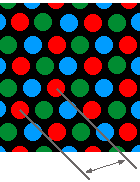
The vast majority of computer monitors use circular blobs of phosphor and arrange them in triangular formation. These groups are known as triads and the arrangement is a dot trio design. The shadow mask is located directly behind the phosphor layer – each perforation corresponding with phosphor dot trios – and assists in masking unnecessary electrons, avoiding overspill and resultant blurring of the final picture.
Because the distance between the source and the destination of the electron stream towards the middle of the screen is smaller than at the edges, the corresponding area of the shadow mask get hotter. To prevent it from distorting – and redirecting the electrons incorrectly – manufacturers typically construct it from Invar, an alloy with a very low coefficient of expansion.
This is all very well, except that the shadow mask used to avoid overspill occupies a large percentage of the screen area. Where there are portions of mask, there’s no phosphor to glow and less light means a duller image.
The brightness of an image matters most for full-motion video and with multimedia becoming an increasing important market consideration a number of improvements have been made to make dot-trio mask designs brighter. Most approaches to minimising glare involve filters that also affect brightness. The new schemes filter out the glare without affecting brightness as much.
Toshiba’s Microfilter CRT places a separate filter over each phosphor dot and makes it possible to use a different colour filter for each colour dot. Filters over the red dots, for example, let red light shine through, but they also absorb other colours from ambient light shining on screen – colours that would otherwise reflect off as glare. The result is brighter, purer colours with less glare. Other companies are offering similar improvements. Panasonic’s Crystal Vision CRTs use a technology called dye-encapsulated phosphor, which wraps each phosphor particle in its own filter and ViewSonic offers an equivalent capability as part of its new SuperClear screens.
- The Anatomy of a CRT Monitor (and CRT TVs)
- CRT Monitor Resolution and Refresh Rates (VSF)
- Monitor Interlacing
- What is the Dot Pitch of a Computer Monitor
- Dot Trio Monitors
- Grill Aperture Monitors
- Monitor Technologies: Slotted Mask
- Enhanced Dot Pitch Monitors
- Electron Beam Monitors
- Monitor Controls
- The Different Types of CRT Monitors – From ShortNeck to FST
- What is a Digital CRT Monitor and How Does It Work
- What is LightFrame Technology?
- Safety Standards For Computer Monitors
- TCO Monitor Standards
- Monitor Ergonomics